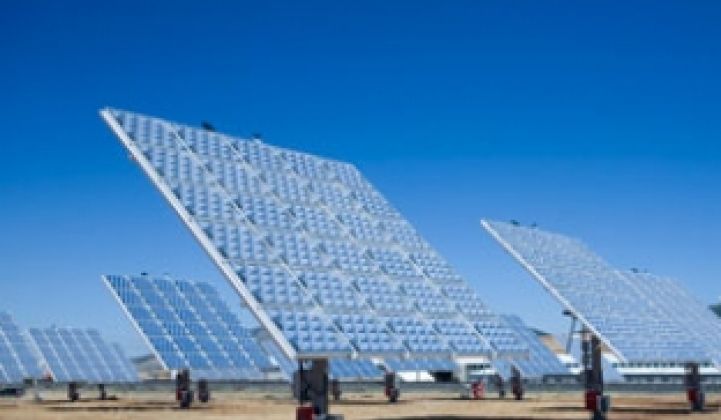For solar concentrators, the question isn't the economy – it's the technology and the cost. With costs of conventional silicon modules dropping due to overcapacity and the performance of thin film and crystalline silicon still improving, CPV is in a race to keep up with commodifying conventional PV and large-scale solar thermal.
The concentrated photovoltaic market is still in its infancy and SolFocus is one of the more prominent firms in this emerging solar technology sector (for extensive lists of CPV firms see these Green Light posts CPV, Pt. 1: Stuck in the Middle and 150 Solar Startups, Pt. 2: CPV.)
I recently spoke with Nancy Hartsoch, the VP of Marketing at SolFocus for some insight into the CPV market and her outlook for 2009.
Hartsoch estimates that 10 megawatts of CPV was deployed in 2008 and she predicts 50 megawatts will be deployed in 2009. That's still a small percentage of total annual solar deployment, which according to GTM Research's solar analysts was about 5.5 gigawatts in 2008 and could range from 5 gigawatts to 7 gigawatts in 2009. But 5X growth is still 5X growth.
"The economy is not the limiter, it's whether can we turn our prototyping to scale. For SolFocus – engineering is finished – we're now transitioning to commercialization," said Hartsoch.
SolFocus had capitalized on the Spanish feed-in tariff with "half a megawatt deployment" in Spain. "The overall tone [at a recent CPV meeting] from the Spanish companies was much more negative because their markets are Spain-centric," said Hartsoch. And despite the welcome that Spain has had for CPV, "Spain is not super-high DNI." (Though this map seems to say otherwise.)
But CPV isn't limited to Spain or the Southwestern U.S. for that matter – SolFocus is closing deals in Greece (it recently increased an agreement with Greece's Samaras Group from 1.6 megawatts to 10 megawatts) and apparently Portugal has a lot of opportunity. There's also a lot of potential in North Africa and South Africa.
SolFocus is looking at a number of projects in the 5-megawatt to 10-megawatt range for 2009. "Project finance is a challenge but not our biggest challenge. It's almost an advantage to be at these modest sizes," Hartsoch added. (Compared to a PV firm trying to finance a 500-megawatt solar farm like say, OptiSolar, R.I.P.). SolFocus looks to have 100 megawatts of capacity in place by the end of the year.
High-concentration PV systems require non-silicon, super-high efficiency compound semiconductor solar cells to make the system economically feasible. Until now CPV systems makers have had to rely on Emcore and Spectrolab as suppliers. Both of these firms have been vendors of solar cells for space applications and that carries both good and not-so-good baggage – fantastic quality with less than fantastic pricing. But, according to Hartsoch: "Emcore and Spectrolab are starting to come around as commercial companies. They are not yet commodity suppliers but are dramatically better than before."
There are a few startups going after the CPV semiconductor business such as Cyrium, QuantaSol and the secretive Solar Junction. If the CPV market is going to grow to 50 megawatts and beyond it will require millions of solar cells. "It's going to have to be a collaborative effort," said Hartsoch.
Obtaining VC funding for SolFocus was relatively easy in 2006 and 2007. The promising firm closed large rounds, added headcount and even acquired a few other small firms to address its supply chain. That left it facing 2008 and 2009 economics with a painfully large burn-rate and lots of hungry mouths to feed. Closing its latest round has been a bit more complicated. The firm was looking to close a $60 million to $80 million round mid-last year. That turned into a $47.5 first close of a C round in January of this year. And the final close of the C round is expected soon despite misinformation to the contrary (see SolFocus Adds $19.28M to Series C). Almost every VC round of late is a “down round” and SolFocus is no exception.
Other firms active in CPV systems are Amonix, GreenVolts, Concentri and Solar Systems. According to New Energy Finance, the majority of CPV systems installed today have utilized HCPV technology from Amonix.
Eric Wesoff is a Senior Analyst with GTM Research contributing to Greentech Media News.



